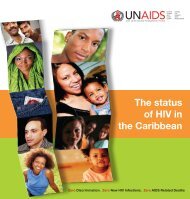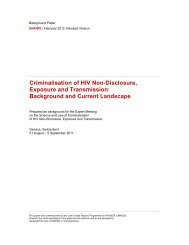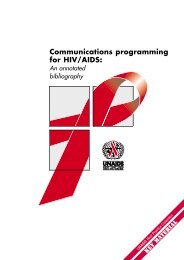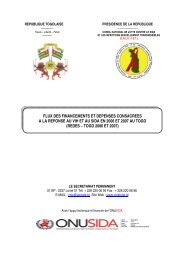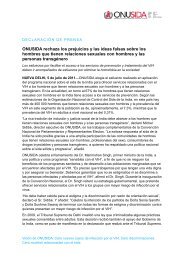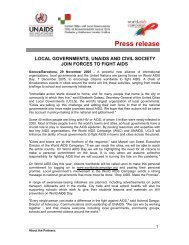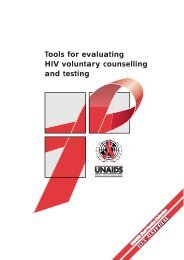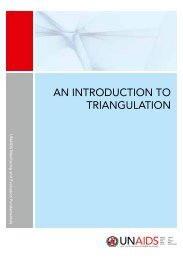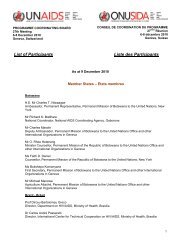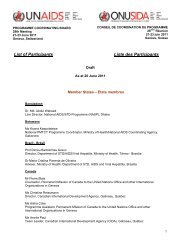National Commitments and Policies Instrument (NCPI ... - UnAIDS
National Commitments and Policies Instrument (NCPI ... - UnAIDS
National Commitments and Policies Instrument (NCPI ... - UnAIDS
Create successful ePaper yourself
Turn your PDF publications into a flip-book with our unique Google optimized e-Paper software.
Yes<br />
Teacher training?:<br />
Yes<br />
2.2. Does the strategy include age-appropriate, gender-sensitive sexual <strong>and</strong> reproductive health elements?:<br />
Yes<br />
2.3. Does the country have an HIV education strategy for out-of-school young people?:<br />
Yes<br />
3. Does the country have a policy or strategy to promote information, education <strong>and</strong> communication <strong>and</strong> other<br />
preventive health interventions for key or other vulnerable sub-populations?:<br />
No<br />
Briefly describe the content of this policy or strategy:<br />
-<br />
3.2. Overall, on a scale of 0 to 10 (where 0 is “Very Poor” <strong>and</strong> 10 is “Excellent”), how would you rate policy efforts<br />
in support of HIV prevention in 2011?:<br />
5<br />
Since 2009, what have been key achievements in this area:<br />
la proportion des femmes et hommes de 15 a 24 ans ayant utilisée le preservatif lors de la première relation sexuelle a été de<br />
23 et 34% em 2009.<br />
What challenges remain in this area:<br />
D’ici 2015: 80% de jeunes de 15 à 24 ans ont réalisé leur dépistage du VIH ; Le taux d’utilisation des préservatifs lors du<br />
dernier rapport sexuel à risque chez les jeunes filles et garçons de 15 – 24 ans est porté à 80%; 95% des écoles intègrent<br />
l’enseignement d’EVF/EMP/VIH dans les curricula scolaires La prévalence du VIH chez les jeunes/adolescents âgés de 15 à<br />
24 ans baisse de moitié;<br />
4. Has the country identified specifc needs for HIV prevention programmes?:<br />
Yes<br />
IF YES, how were these specific needs determined?:<br />
-<br />
4.1. To what extent has HIV prevention been implemented?<br />
Blood safety:<br />
Strongly Agree<br />
Condom promotion:<br />
Strongly Agree<br />
Harm reduction for people who inject drugs:<br />
Agree<br />
HIV prevention for out-of-school young people:<br />
Strongly Agree<br />
HIV prevention in the workplace:<br />
Agree<br />
HIV testing <strong>and</strong> counseling:<br />
Strongly Agree<br />
IEC on risk reduction:<br />
Strongly Agree<br />
IEC on stigma <strong>and</strong> discrimination reduction:<br />
Strongly Agree<br />
Prevention of mother-to-child transmission of HIV:<br />
Strongly Agree<br />
Prevention for people living with HIV:<br />
Strongly Agree<br />
Reproductive health services including sexually transmitted infections prevention <strong>and</strong> treatment:<br />
Strongly Agree<br />
Risk reduction for intimate partners of key populations:<br />
Agree<br />
Risk reduction for men who have sex with men:<br />
Agree<br />
Risk reduction for sex workers:<br />
Agree<br />
School-based HIV education for young people:<br />
Agree<br />
Universal precautions in health care settings:<br />
Agree<br />
Other[write in]:<br />
-<br />
5. Overall, on a scale of 0 to 10 (where 0 is “Very Poor” <strong>and</strong> 10 is “Excellent”), how would you rate the efforts in<br />
implementation of HIV prevention programmes in 2011?:<br />
'8'



